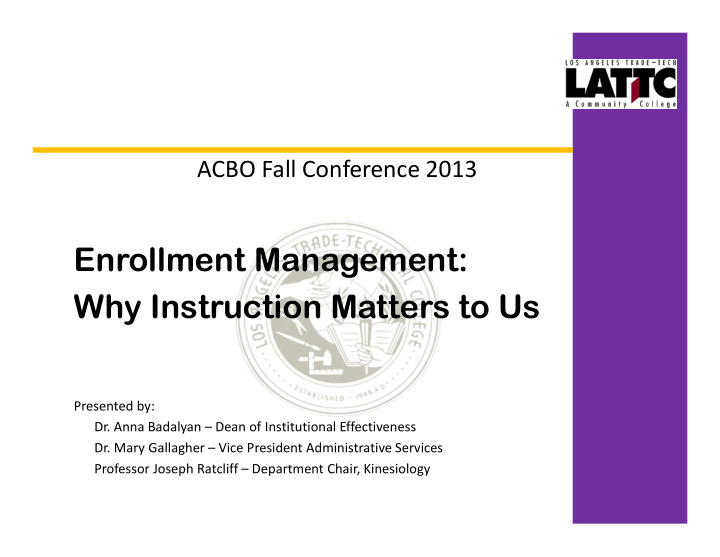



ACBO Fall Conference 2013 Enrollment Management: Why Instruction Matters to Us Presented by: Dr. Anna Badalyan – Dean of Institutional Effectiveness Dr. Mary Gallagher – Vice President Administrative Services Professor Joseph Ratcliff – Department Chair, Kinesiology
Who We Are • LATTC is a community college south of downtown Los Angeles • Almost 90 years old • FTES of approximately 12,000 (credit and non-credit) • About 90% of our student test into basic skills and below • At ground zero on the economic and educationally disadvantaged scale
What We Do • Over 80% of our courses taught by full-time faculty • 54% of our budget is spent on instruction • 75% of the program offerings are Career Technical Education • Over $1.5 million annually spent on instructional supplies and equipment from the general fund If you believe - you can do it too!
The Budget and Instruction • Instruction is who we are and what we do • Hourly instructional spending can be the easiest line item to reduce when budgets are cut • Without monitoring hourly instruction can present an overwhelming expense • It takes the cooperation of Academic Affairs and the Budget Office in order to strategically manage enrollment • Deans and department chairs work together on the schedule of classes
Reducing the Class Schedule 2008-09 faced with a budget deficit classes were cut across the board • Projections 2007-08 Actual 2008-09 Projections as of 11/5/08 w/Reductions Std Std 0811 Expenditures Hours Term FTES Hrs Current Proj Actual Hours Est FTES $3,802,23 $4,166,656 53438Fall 2007 4878 Fall 2008 54460 $3,710,798 5 54004 5600 $1,355,430 16903Winter 2008 721 Winter 2009 11992 $817,112 10875 507.5 $4,432,206 56988Spring 2008 5074 Spring 2009 52317 $3,564,779 46664 4839 Summer2 Summer2 $1,273,65 $1,089,997 20407 2007 838 2008 21349 $1,454,679 2 21349 1100 Summer 1 Summer 1 $476,834 21349 2008 925 2009 21349 $581,896 15000 600 16146 $11,521,123 169085 12436 7 $10,129,264 147892 12646.5 Cost per Std Hour $68.14 FTES Goal 12740 Proj Hrly $10,077,07 $ 3 Hrly $ Target 10,500,000
Further Reductions of 2009-11 State Chancellor’s directive: Basic Skills, Transfer and Workforce • (we added faculty load) Rollover schedule • – Everything that did not meet this criteria was removed from the schedule – Classes were added that still met some criteria to meet the FTES target Goal of increasing class size • – Average class size was under 30 Meet FTES in Fall and Spring terms • – The beginning of strategically managing for improved economy Terms such as “ efficiency ” became the language used •
Managing the ARCC Measures 2011 -12 With extremely low ARCC numbers the development of • strategies to improve student success took center stage The refinement of the FTEF allocation model included • improving competencies so students have a focus on program completions Dedicated our noncredit instruction to incoming student • preparation The same year we updated our Educational Master Plan and • Strategic Priorities The FTEF Allocation formula included the following • components: – base, efficiency, success, and innovation
Issues from the Classroom Timeline Overall Goal(s) Issues 2008 - 2009 Balance Budget - Deep reduction in number of $4 m in 5 days offering across the board. Lack of valuable data. 2009 - 2010 Efficiency – Class Was not driven by student Size success 2010 - 2012 Improve Outcomes; Lack of qualitative data and Institutional multiple measure indicators Effectiveness 2012 - Student Success - Chair and faculty getting better Present Completion understanding – but process seems to keep changing
Strategic Scheduling & Services for Student Success (S5) • Student Success Initiative (SB1456) – College-wide commitment to student success – Integration of instruction and support for instruction – Customer service approach to services – One-stop for all student inquiries • Enrollment Management – Chairs have worked with the FTEF allocation for three years – Offerings are targeted to program completion not just class offerings – Curriculum improvement drives part of the allocation • Strategic Cost Management Model – Essential/Supports Essential/Value Added/Innovation
Developing a Dashboard FTES - 4% above base FTEF Annual Allocation to Departments • Allocation based on Last 3 Years: Historical; Efficiency • (FTES/FTEF); Success rates Set aside 5-10% for innovation • Scheduling Degree, Certificate and Transfer Certification Completion • (Winter & Spring - students’ need to complete a program) College Prep/Basic Skills (Summer & Fall) • Restoration of LATTC Evening/Weekend Program • New Program Strategy/Innovation •
Results and Lessons Learned • We are proud of our enrollment management and scheduling because we have the ability to: – Establish an FTES target – Build a schedule to meet that target – Ensure our students have every opportunity to complete their program – Cost out the schedule • We learned through this process that: – You need stakeholder involvement and buy-in – Goals must drive results – We always need to look forward – what is on the horizon – Document strategies and results – Transparency and communication are the keys to success
The Future Pathways to academic, career and transfer success • (PACTS) – Ensuring students are prepared when they enter college level classes – Competency based Developing a two-year schedule • – Guaranteed offerings to complete programs Strategic Cost Management Model • – Essential – Supports essential – Value added – Innovation
Questions??
Recommend
More recommend